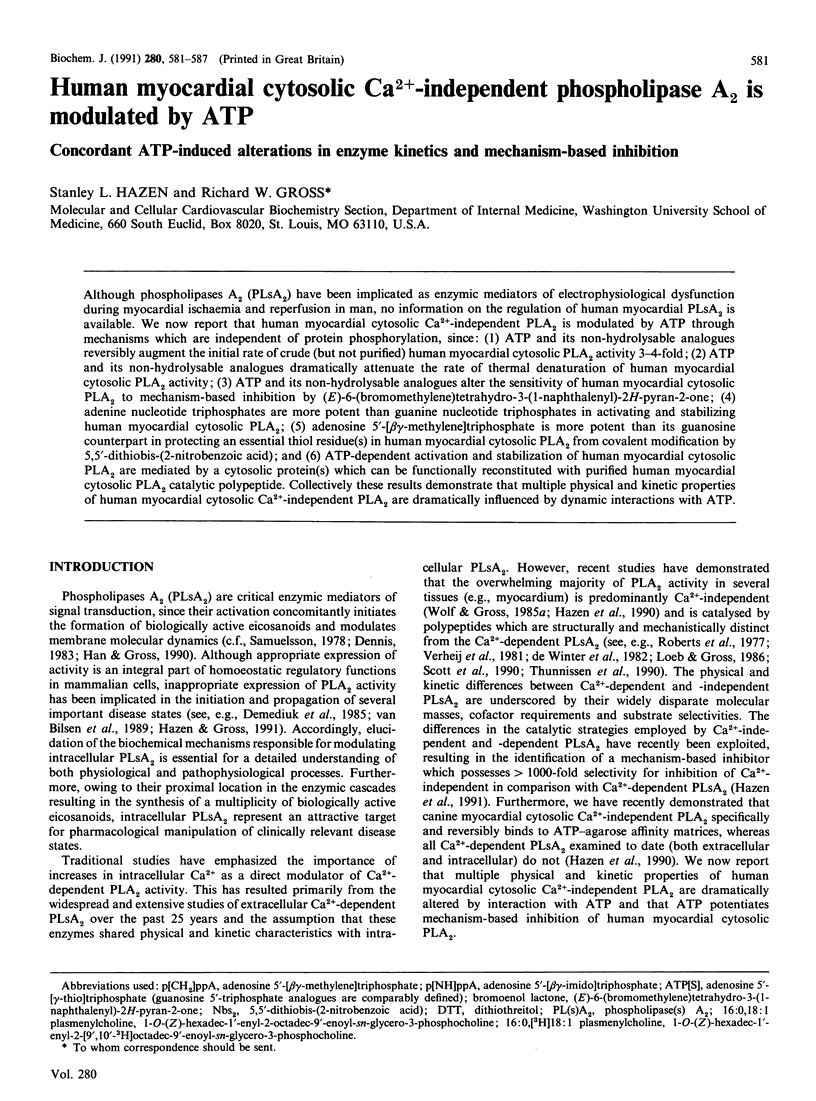Abstract
Although phospholipases A2 (PLsA2) have been implicated as enzymic mediators of electrophysiological dysfunction during myocardial ischaemia and reperfusion in man, no information on the regulation of human myocardial PLsA2 is available. We now report that human myocardial cytosolic Ca(2+)-independent PLA2 is modulated by ATP through mechanisms which are independent of protein phosphorylation, since: (1) ATP and its non-hydrolysable analogues reversibly augment the initial rate of crude (but not purified) human myocardial cytosolic PLA2 activity 3-4 fold; (2) ATP and its non-hydrolysable analogues dramatically attenuate the rate of thermal denaturation of human myocardial cytosolic PLA2 activity; (3) ATP and its non-hydrolysable analogues alter the sensitivity of human myocardial cytosolic PLA2 to mechanism-based inhibition by (E)-6-(bromomethylene)tetrahydro-3-(1-naphthalenyl)-2H-pyran-2-one; (4) adenine nucleotide triphosphates are more potent than guanine nucleotide triphosphates in activating and stabilizing human myocardial cytosolic PLA2; (5) adenosine 5'-[beta gamma-methylene]triphosphate is more potent than its guanosine counterpart in protecting an essential thiol residue(s) in human myocardial cytosolic PLA2 from covalent modification by 5,5'-dithiobis-(2-nitrobenzoic acid); and (6) ATP-dependent activation and stabilization of human myocardial cytosolic PLA2 are mediated by a cytosolic protein(s) which can be functionally reconstituted with purified human myocardial cytosolic PLA2 catalytic polypeptide. Collectively these results demonstrate that multiple physical and kinetic properties of human myocardial cytosolic Ca(2+)-independent PLA2 are dramatically influenced by dynamic interactions with ATP.
Full text
PDF






Selected References
These references are in PubMed. This may not be the complete list of references from this article.
- Birnbaumer L., Abramowitz J., Brown A. M. Receptor-effector coupling by G proteins. Biochim Biophys Acta. 1990 May 7;1031(2):163–224. doi: 10.1016/0304-4157(90)90007-y. [DOI] [PubMed] [Google Scholar]
- Creer M. H., Gross R. W. Reversed-phase high-performance liquid chromatographic separation of molecular species of alkyl ether, vinyl ether, and monoacyl lysophospholipids. J Chromatogr. 1985 Feb 27;338(1):61–69. doi: 10.1016/0378-4347(85)80070-0. [DOI] [PubMed] [Google Scholar]
- De Winter J. M., Vianen G. M., Van den Bosch H. Purification of rat liver mitochondrial phospholipase A2. Biochim Biophys Acta. 1982 Aug 18;712(2):332–341. doi: 10.1016/0005-2760(82)90351-4. [DOI] [PubMed] [Google Scholar]
- Demediuk P., Saunders R. D., Anderson D. K., Means E. D., Horrocks L. A. Membrane lipid changes in laminectomized and traumatized cat spinal cord. Proc Natl Acad Sci U S A. 1985 Oct;82(20):7071–7075. doi: 10.1073/pnas.82.20.7071. [DOI] [PMC free article] [PubMed] [Google Scholar]
- Gard J. K., Kichura G. M., Ackerman J. J., Eisenberg J. D., Billadello J. J., Sobel B. E., Gross R. W. Quantitative 31P nuclear magnetic resonance analysis of metabolite concentrations in Langendorff-perfused rabbit hearts. Biophys J. 1985 Nov;48(5):803–813. doi: 10.1016/S0006-3495(85)83839-X. [DOI] [PMC free article] [PubMed] [Google Scholar]
- Gilman A. G. G proteins: transducers of receptor-generated signals. Annu Rev Biochem. 1987;56:615–649. doi: 10.1146/annurev.bi.56.070187.003151. [DOI] [PubMed] [Google Scholar]
- Hazen S. L., Stuppy R. J., Gross R. W. Purification and characterization of canine myocardial cytosolic phospholipase A2. A calcium-independent phospholipase with absolute f1-2 regiospecificity for diradyl glycerophospholipids. J Biol Chem. 1990 Jun 25;265(18):10622–10630. [PubMed] [Google Scholar]
- Hazen S. L., Zupan L. A., Weiss R. H., Getman D. P., Gross R. W. Suicide inhibition of canine myocardial cytosolic calcium-independent phospholipase A2. Mechanism-based discrimination between calcium-dependent and -independent phospholipases A2. J Biol Chem. 1991 Apr 15;266(11):7227–7232. [PubMed] [Google Scholar]
- Loeb L. A., Gross R. W. Identification and purification of sheep platelet phospholipase A2 isoforms. Activation by physiologic concentrations of calcium ion. J Biol Chem. 1986 Aug 15;261(23):10467–10470. [PubMed] [Google Scholar]
- Roberts M. F., Deems R. A., Mincey T. C., Dennis E. A. Chemical modification of the histidine residue in phospholipase A2 (Naja naja naja). A case of half-site reactivity. J Biol Chem. 1977 Apr 10;252(7):2405–2411. [PubMed] [Google Scholar]
- Samuelsson B., Goldyne M., Granström E., Hamberg M., Hammarström S., Malmsten C. Prostaglandins and thromboxanes. Annu Rev Biochem. 1978;47:997–1029. doi: 10.1146/annurev.bi.47.070178.005025. [DOI] [PubMed] [Google Scholar]
- Scott D. L., White S. P., Otwinowski Z., Yuan W., Gelb M. H., Sigler P. B. Interfacial catalysis: the mechanism of phospholipase A2. Science. 1990 Dec 14;250(4987):1541–1546. doi: 10.1126/science.2274785. [DOI] [PMC free article] [PubMed] [Google Scholar]
- Thunnissen M. M., Ab E., Kalk K. H., Drenth J., Dijkstra B. W., Kuipers O. P., Dijkman R., de Haas G. H., Verheij H. M. X-ray structure of phospholipase A2 complexed with a substrate-derived inhibitor. Nature. 1990 Oct 18;347(6294):689–691. doi: 10.1038/347689a0. [DOI] [PubMed] [Google Scholar]
- Verheij H. M., Slotboom A. J., de Haas G. H. Structure and function of phospholipase A2. Rev Physiol Biochem Pharmacol. 1981;91:91–203. doi: 10.1007/3-540-10961-7_3. [DOI] [PubMed] [Google Scholar]
- Weiss J. N., Lamp S. T. Glycolysis preferentially inhibits ATP-sensitive K+ channels in isolated guinea pig cardiac myocytes. Science. 1987 Oct 2;238(4823):67–69. doi: 10.1126/science.2443972. [DOI] [PubMed] [Google Scholar]
- Wolf R. A., Gross R. W. Identification of neutral active phospholipase C which hydrolyzes choline glycerophospholipids and plasmalogen selective phospholipase A2 in canine myocardium. J Biol Chem. 1985 Jun 25;260(12):7295–7303. [PubMed] [Google Scholar]
- Wolf R. A., Gross R. W. Semi-synthetic approach for the preparation of homogeneous plasmenylethanolamine utilizing phospholipase D from Streptomyces chromofuscus. J Lipid Res. 1985 May;26(5):629–633. [PubMed] [Google Scholar]
- van Bilsen M., van der Vusse G. J., Willemsen P. H., Coumans W. A., Roemen T. H., Reneman R. S. Lipid alterations in isolated, working rat hearts during ischemia and reperfusion: its relation to myocardial damage. Circ Res. 1989 Feb;64(2):304–314. doi: 10.1161/01.res.64.2.304. [DOI] [PubMed] [Google Scholar]


